Human Health Risk Associated with As, Cu, Pb, and Zn in Soils of the Aconcagua and Casablanca River Basins, Valparaíso Region, Chile
Abstract
1. Introduction
2. Materials and Methods
2.1. Study Area
2.2. Geology
2.3. Data Selection and Statistical Analysis
2.4. Threshold Values
2.5. Positive Matrix Factorization
2.6. Environmental Indexes
2.7. Human Health Risk Assessment
Noncarcinogenic Risk Characterization
3. Results and Discussion
3.1. Exploratory Data Analysis
3.2. Spatial Distribution
3.3. Geochemical Baseline
3.4. Grouping of the Elements
3.5. Environmental Indexes
3.6. Health Risks
4. Conclusions
Supplementary Materials
Author Contributions
Funding
Institutional Review Board Statement
Informed Consent Statement
Data Availability Statement
Acknowledgments
Conflicts of Interest
References
- Bost, M.; Houdart, S.; Oberli, M.; Kalonji, E.; Huneau, J.F.; Margaritis, I. Dietary copper and human health: Current evidence and unresolved issues. J. Trace Elem. Med. Biol. 2016, 35, 107–115. [Google Scholar] [CrossRef]
- USEPA. METHOD 6020B-Inductively Coupled Plasma Mass Spectrometry; United States Environmental Protection Agency: Washington, DC, USA, 2014. [Google Scholar]
- Riquelme, C. Análisis Estadístico de Doncentraciones y Distribuciones de Metales Pesados para el Municipio de Sentmenat, España. Ph.D. Dissertation, Universidad Católica de la Santísima Concepción, Concepción, Chile, 2015. [Google Scholar]
- Tume, P.; King, R.; González, E.; Bustamante, G.; Reverter, F.; Roca, N.; Bech, J. Trace element concentrations in schoolyard soils from the port city of Talcahuano, Chile. J. Geochem. Explor. 2014, 147, 229–236. [Google Scholar] [CrossRef]
- Reimann, C.; Garrett, R. Geochemical background—Concept and reality. Sci. Total Environ. 2005, 350, 12–27. [Google Scholar] [CrossRef]
- Ander, E.L.; Johnson, C.C.; Cave, M.R.; Palumbo-Roe, B.; Nathanail, C.P.; Lark, R.M. Method-ology for the determination of normal background concentrations of contaminants in English soil. Sci. Total Environ. 2013, 454, 604–618. [Google Scholar] [CrossRef]
- Kowalska, J.B.; Mazurek, R.; Gąsiorek, M.; Zaleski, T. Pollution indices as useful tools for the comprehensive evaluation of the degree of soil contamination–A review. Environ. Geochem. Health 2018, 40, 2395–2420. [Google Scholar] [CrossRef] [PubMed]
- Loska, K.; Cebula, J.; Pelczar, J.; Wiechula y Kwapilinski, D. Use of Enrichment and Contamination Factors Together with Geoaccumulation Indexes to Evaluate the Content of Cd, Cu, and Ni in the Rynik Water Reservoir in Poland. Water Air Pollut. 1997, 93, 347–365. [Google Scholar] [CrossRef]
- Moreira, A.C.; Boaventura, R.Y.R.G. Referencia geoquímica regional, para la interpretación de las concentraciones de elementos químicos nos sedimentos da Bacia do lago Paranoá-DF. Química Nova 2003, 6, 812–820. [Google Scholar] [CrossRef]
- Hakanson, L. An ecological risk index for aquatic pollution control: A sedimentological approach. Water Res. 1980, 14, 975–1001. [Google Scholar] [CrossRef]
- Diami, S.M.; Kusin, F.M.; Madzin, Z. Potential ecological and human health risks of heavy metals in surface soils associated with iron ore mining in Pahang, Malaysia. Environ. Sci. Pollut. Res. 2016, 23, 21086–21097. [Google Scholar] [CrossRef]
- Antoniadis, V.; Shaheen, S.M.; Levizou, E.; Shahid, M.; Niazi, N.K.; Vithanage, M.; Ok, Y.S.; Bolan, N.; Rinklebe, J. A critical prospective analysis of the potential toxicity of trace element regulation limits in soils worldwide: Are they protective concerning health risk assessment?-A review. Environ. Int. 2019, 127, 819–847. [Google Scholar] [CrossRef]
- Ministry of Environment, CORFO, Fundación Chile. 2012. Available online: https://mma.gob.cl/estructura-organizacional/ (accessed on 1 May 2023).
- USEPA. Supplemental Guidance for Developing Soil Screening Levels for Superfund Sites; United States Environment Protection Agency: Washington, DC, USA, 2002. [Google Scholar]
- USEPA. Regional Screening Levels (RSLs): Generic Tables; USEPA: Washington, DC, USA, 2020. [Google Scholar]
- Scheinberg, I.H. Human Health Effects of Copper. In Copper in the Environment: Part II: Health Effects; Nriagu, J.O., Ed.; John Wiley & Sons: New York, NY, USA, 1979; pp. 17–31. [Google Scholar]
- Turnlund, J.R.; Keyes, W.R.; Kim, S.K.; Domek, J.M. Long-term high copper intake: Effects on copper absorption retention homeostasis in men. Am. J. Clin. Nutr. 2005, 81, 822–828. [Google Scholar] [CrossRef] [PubMed]
- USEPA. Renewable Fuel Standard Program (RFS2) Regulatory Impact Analysis; US Environmental Protection Agency: Washington, DC, USA, 2010. [Google Scholar]
- Pan, Y.; Peng, H.; Xie, S.; Zeng, M.; Huang, C. Eight elements in soils from a typical light industrial city, China: Spatial distribution, ecological assessment, and the source apportionment. Int. J. Environ. Res. Public Health 2019, 16, 2591. [Google Scholar] [CrossRef] [PubMed]
- Lim, H.; Lee, J.; Chon, H.; Sager, M. Heavy metal contamination and health risk assessment in the vicinity of the abandoned Songcheon Au-Ag mine in Korea. J. Geochem. Explor. 2008, 96, 223–230. [Google Scholar] [CrossRef]
- USEPA (United States Environment Protection Agency). Exposure Factors Handbook 2011 Edition (Final); EPA/600/R-09/052F; US Environmental Protection Agency: Washington, DC, USA, 2011. [Google Scholar]
- Kan, S.; Cao, Q.; Zheng, Y.; Huang, Y.; Zhu, Y. Health risks of heavy metals in contaminated soils and food crops irrigated with wastewater in Beijing, China. Environ. Pollut. 2008, 152, 686–692. [Google Scholar] [CrossRef] [PubMed]
- Manta, D.S.; Angelone, M.; Bellanca, A.; Neri, R.; Sprovieri, M. Heavy metals in urban soils: A case study from the city of Palermo (Sicily), Italy. Sci. Total Environ. 2002, 300, 229–243. [Google Scholar] [CrossRef]
- Schoffer, J.T.; Sauvé, S.; Neaman, A.; Ginocchio, R. Role of leaf litter on the incorporation of copper-containing pesticides into soils under fruit production: A review. J. Soil Sci. Plant Nutr. 2020, 20, 990–1000. [Google Scholar] [CrossRef]
- AFIPA. Manual Fitosanitario; Asociación Nacional de Fabricantes e Importadores de Productos Fi-tosanitarios Agrícolas (AFIPA): Santiago, Chile, 2002–2003. [Google Scholar]
- Tume, P.; Gonza’lez, E.; Reyes, F.; Fuentes, J.P.; Roca, N.; Bech, J.; Medina, G. Sources analysis and health risk assessment of trace elements in urban soils of Hualpen, Chile. CATENA 2019, 175, 304–316. [Google Scholar] [CrossRef]
- Ministry of Environment, CORFO, Fundación Chile. 2024. Available online: https://www.gob.cl/ministerios/ministerio-del-medio-ambiente/ (accessed on 1 May 2023).
- Li, Z.; Ma, Z.; van der Kuijp, T.J.; Yuan, Z.; Huang, L. A review of soil heavy metal pollution from mines in China: Pollution and health risk assessment. Sci. Total Environ. 2014, 468, 843–853. [Google Scholar] [CrossRef]
- Kabata-Pendias, A. Trace Elements in Soils and Plants, 4th ed.; CRC Press; Taylor & Fran-cis Group: Boca Raton, FL, USA, 2010; p. 548. [Google Scholar]
- Shayler, H.; McBride, M.; Harrison, E. Guide to Soil Testing and Interpreting Results; Cornell Waste Management Institute: Ithaca, NY, USA, 2009; pp. 1–6. [Google Scholar]
- Mielke, H.W. Nature and extent of metal-contaminated soils in urban environments (keynote talk). Environ. Geochem. Health 2016, 38, 987–999. [Google Scholar] [CrossRef]
- Isaaks, E.H.; Mohan Srivastava, R. Applied Geostatistics; Oxford University Press: Oxford, UK, 1989; 561p. [Google Scholar]
- Londoño-Franco, L.F.; Londoño-Muñoz, P.T.; Muñoz-García, F.G. Los riesgos de los me-tales pesados en la salud humana y animal. Biotecnol. Sect. Agropecu. Agroind. 2016, 14, 145–153. [Google Scholar] [CrossRef]
- Smedley, P.L.; Kinniburgh, D.G. Source and behavior of arsenic in natural waters. In United Nations Synthesis Report on Arsenic in Drinking Water; World Health Organization: Geneva, Switzerland, 2001; pp. 1–61. [Google Scholar]
- Santibañez, F. Atlas Agroclimático de Chile: Estado Actual y Tendencias del Clima; Centro Agrimed: Santiago, Chile, 2017. [Google Scholar]
- Anaya Raymundo, M.A.; Rangel Morales, F.M.; Iannacone Óliver, J.A.; Romero Echevarría, L.M. Metales pesados en hortalizas y suelos agrícolas irrigados con aguas superficiales: Una revi-sión sistemática. Idesia 2022, 40, 33–41. [Google Scholar] [CrossRef]
- Neaman, A.; Valenzuela, P.; Tapia-Gatica, J.; Selles, I.; Novoselov, A.A.; Dovletyarova, E.A.; Yañez, C.; Krutyakov, Y.A.; Stuckey, J.W. Chilean regulations on metal-polluted soils: The to advance from adapting foreign laws towards developing sovereign legislation. Environ. Res. 2020, 185, 109429. [Google Scholar] [CrossRef] [PubMed]
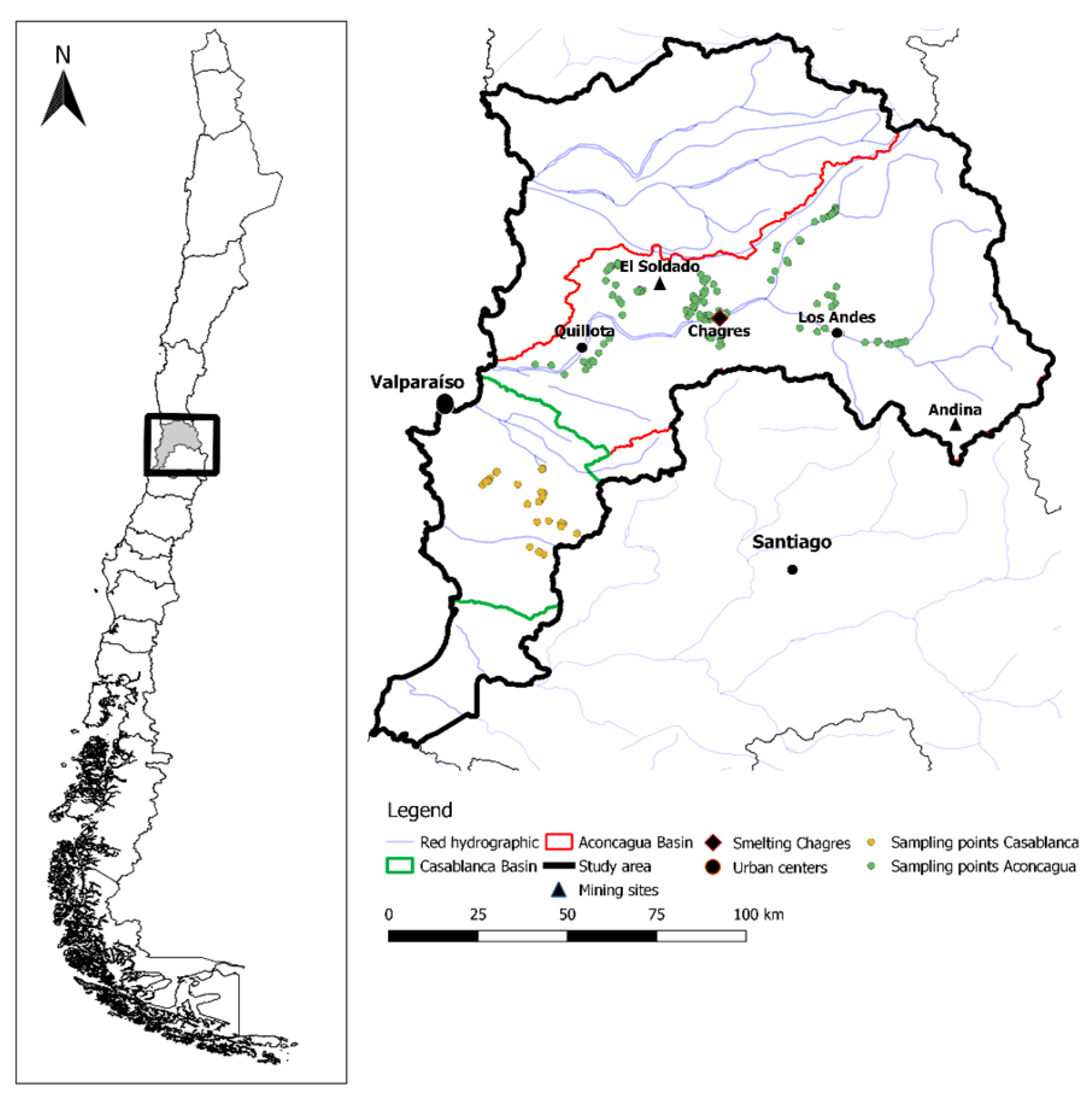
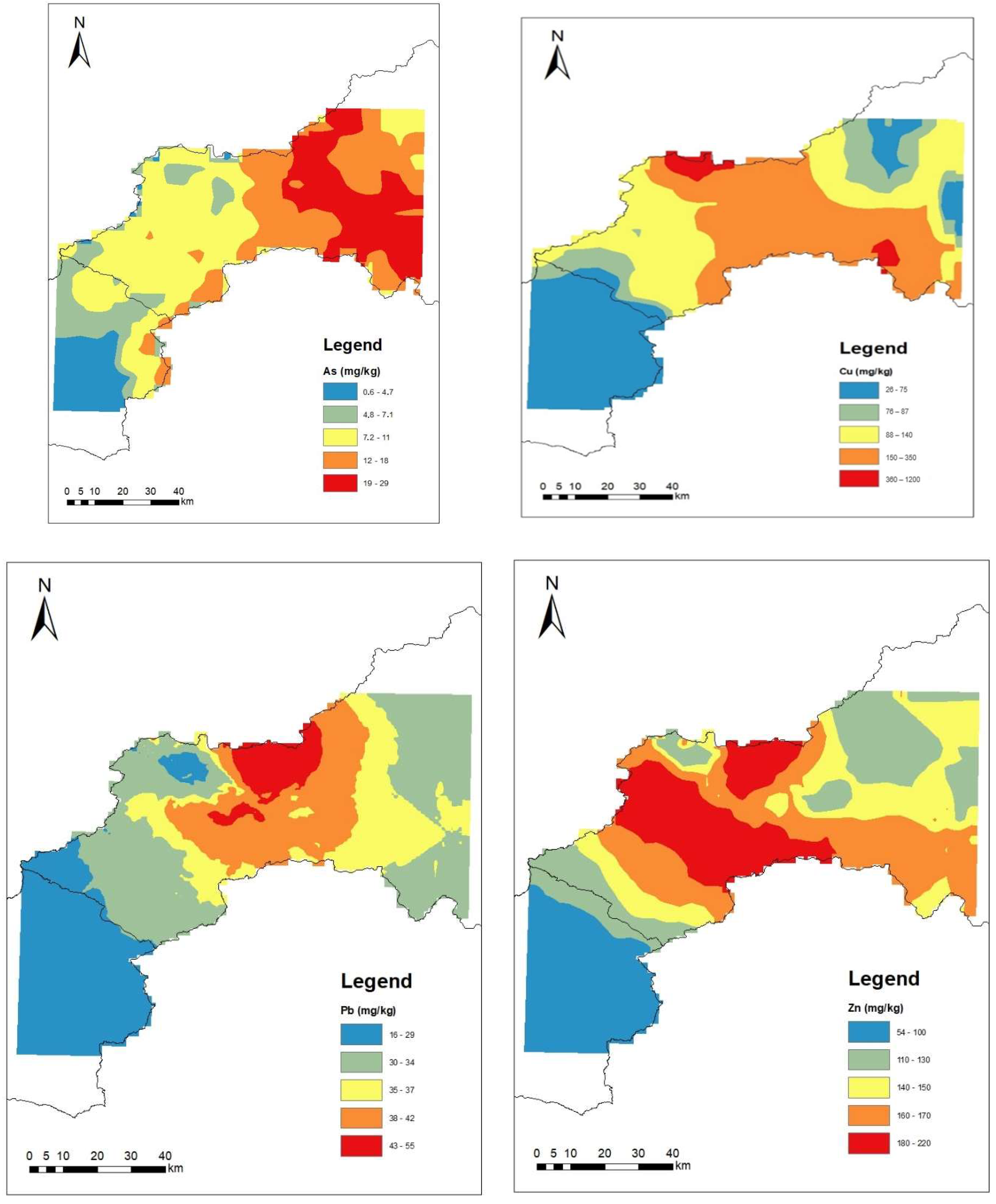

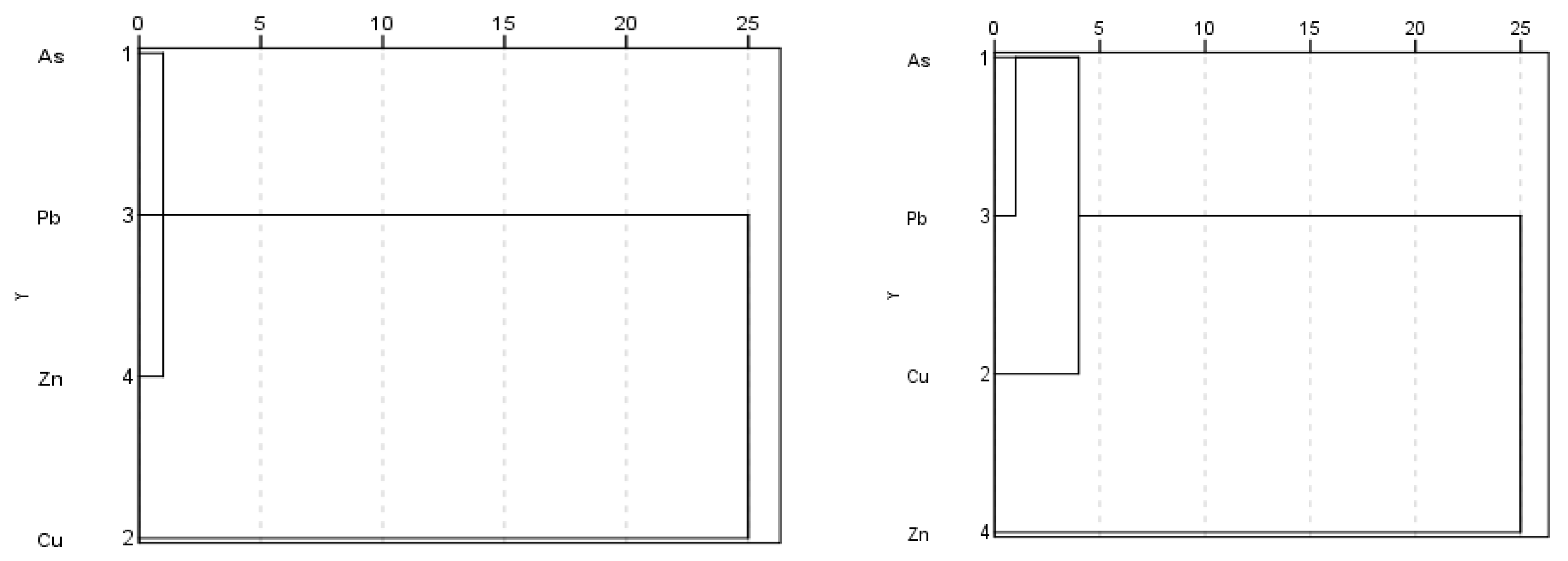
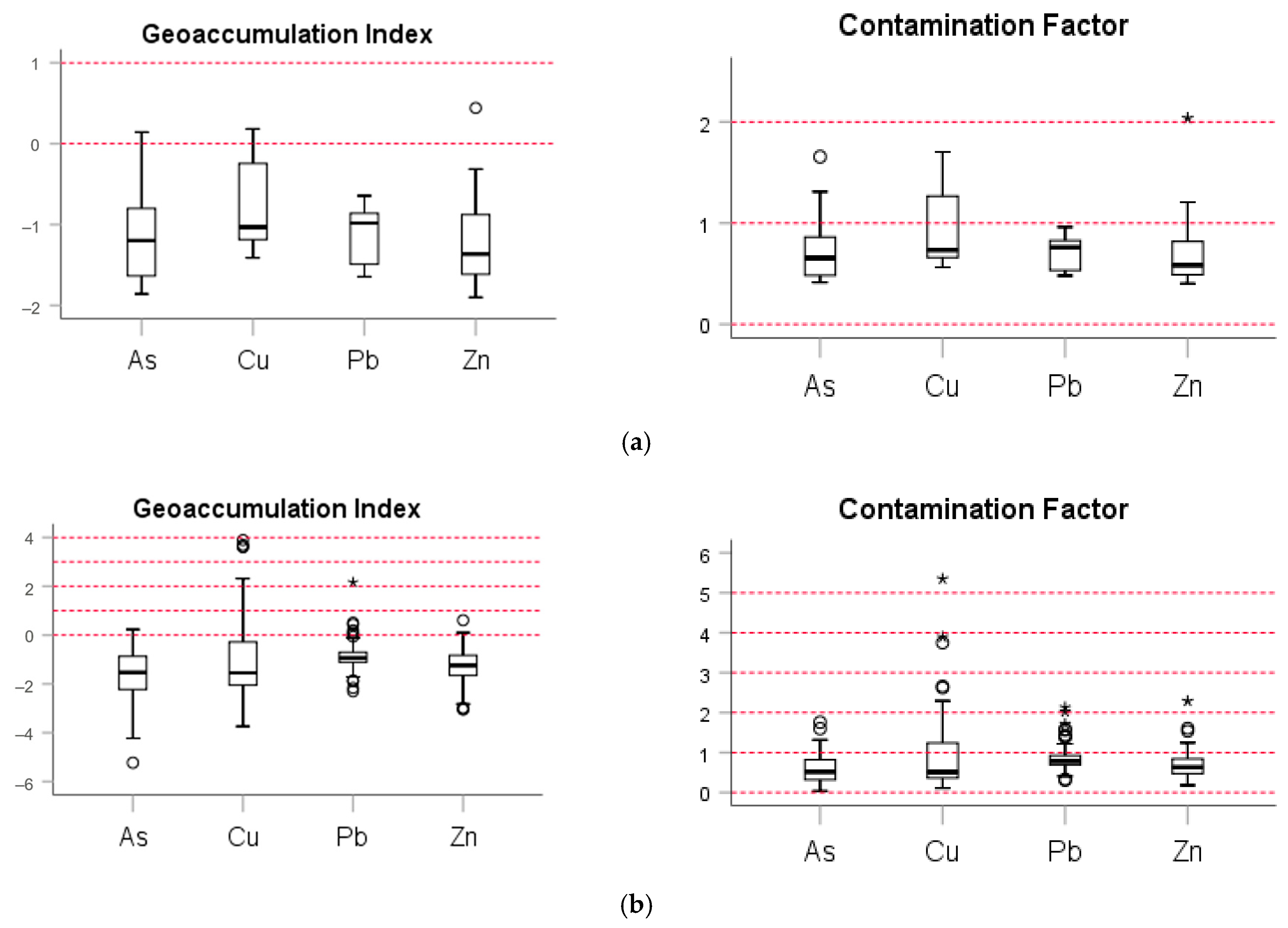




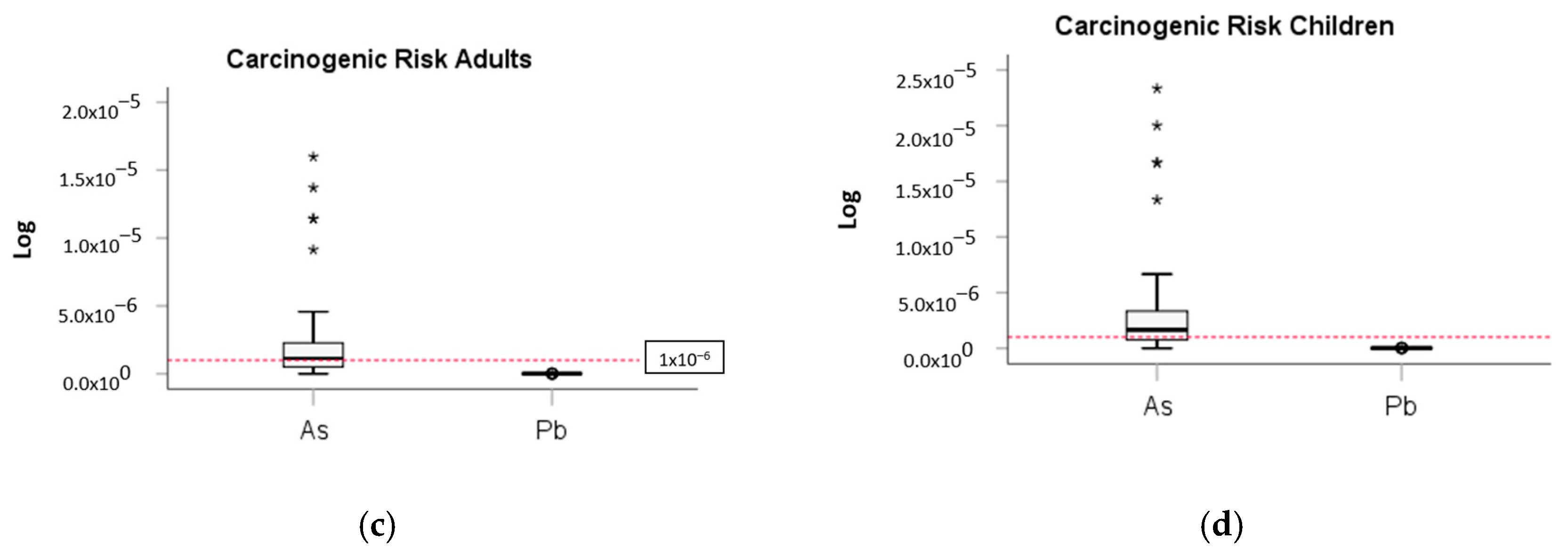
| Aconcagua River Basin (Including Mining Activities) | Aconcagua River Basin (Without Mining Activities) | Casablanca River Basin (Only Agricultural Activities) | |||||||||||
|---|---|---|---|---|---|---|---|---|---|---|---|---|---|
| As | Cu | Pb | Zn | As | Cu | Pb | Zn | As | Cu | Pb | Zn | ||
| Mean | 14.3 | 382.1 | 40.9 | 170.3 | 10.6 | 85.8 | 26.7 | 139.5 | 2.5 | 33.1 | 18.7 | 66.7 | |
| SD a | 8.6 | 868.8 | 27.3 | 76.7 | 4.6 | 32.6 | 5.9 | 73.7 | 3.6 | 13.3 | 5.9 | 20.5 | |
| CV (%) b | 337.5 | 213 | 63.4 | 45.1 | 457.1 | 948.8 | 97.2 | 55.1 | 146.8 | 40.1 | 31.7 | 30.8 | |
| Min. | 1 | 28 | 14 | 46 | 6 | 53 | 18 | 78 | 0 | 10 | 10 | 30 | |
| Max. | 44 | 5581 | 309 | 579 | 24 | 160 | 36 | 395 | 14 | 66 | 41 | 139 | |
| Percentile | 25 | 8 | 90 | 32 | 120 | 7 | 62 | 20 | 95 | 0.4 | 24 | 15 | 56 |
| 50 | 13 | 128 | 36 | 161 | 9.5 | 69 | 28.5 | 113 | 1 | 31 | 17 | 69 | |
| 75 | 21 | 316 | 43 | 216 | 12.8 | 119 | 31 | 159.3 | 2 | 42 | 20 | 80 | |
| Skewness | 0.77 | 4.7 | 7.8 | 1.6 | 1.6 | 0.95 | −0.16 | 2.4 | 2.1 | 0.44 | 2.02 | 0.97 | |
| Geochemical Baseline | Aconcagua River Basin (Including Mining Activity) | Aconcagua River Basin (Without Mining Activity) | Casablanca River Basin (Only Agricultural Activities) | |||||||||
|---|---|---|---|---|---|---|---|---|---|---|---|---|
| As | Cu | Pb | Zn | As | Cu | Pb | Zn | As | Cu | Pb | Zn | |
| 90 | 26.2 | 545 | 55 | 253.2 | 18.4 | 133.5 | 33 | 230.6 | 10 | 51.8 | 28 | 84.4 |
| 95 | 29.6 | 1610.6 | 69.6 | 290 | 23.8 | 158.7 | 35.9 | 386.9 | 12.4 | 61.2 | 33.8 | 105.4 |
| MAD c | 6.29 | 271.1 | 6.81 | 48.7 | 14.5 | 94 | 37. | 194 | 1 | 31 | 17 | 69 |
| Upper Whisker a | 40.5 | 655 | 59.5 | 360 | 21.4 | 204.5 | 47.5 | 255.6 | 4.4 | 69 | 27.5 | 116 |
| Aconcagua River Basin (Including Mining Activity) | Aconcagua River Basin (Without Mining Activity) | Casablanca River Basin (Only Agricultural Activities) | ||||||||||
|---|---|---|---|---|---|---|---|---|---|---|---|---|
| Elements | As | Cu | Pb | Zn | As | Cu | Pb | Zn | As | Cu | Pb | Zn |
| As | 1 | −0.225 * | 0.163 | −0.121 | 1 | −0.186 | 0.593 ** | 0.012 | 1 | 0.038 | −0.169 | 0.333 |
| Cu | 1 | 0.222 * | 0.368 ** | 1 | −0.259 | 0.662 ** | 1 | 0.383 * | 0.511 ** | |||
| Pb | 1 | 0.358 ** | 1 | −0.045 | 1 | 0.472 ** | ||||||
| Zn | 1 | 1 | 1 | |||||||||
| (a) | |||
| Elements | Main Components | ||
| PC1 | PC2 | ||
| As | 0.12 | 0.85 | |
| Cu | 0.57 | −0.06 | |
| Pb | 0.47 | −0.48 | |
| Zn | 0.66 | 0.23 | |
| Variance (%) | 42.7 | 29.7 | |
| Cumulative Variance (%) | 42.7 | 72.4 | |
| (b) | |||
| Elements | Main Components | ||
| PC1 | PC2 | ||
| As | 0.026 | 0.740 | |
| Cu | −0.263 | −0.642 | |
| Pb | 0.677 | −0.113 | |
| Zn | 0.687 | −0.162 | |
| Variance (%) | 41.6 | 30.9 | |
| Cumulative Variance (%) | 41.5 | 72.5 | |
| Aconcagua River Basin | Casablanca River Basin | ||||||||
|---|---|---|---|---|---|---|---|---|---|
| Mining Activities | Vegetable Crops | Fruit Crops | |||||||
| Factor 1 | Factor 2 | Factor 3 | Factor 1 | Factor 2 | Factor 3 | Factor 1 | Factor 2 | Factor 3 | |
| As | 90.5% | 8.4% | 1.1% | 8.1% | 79.3% | 12.6% | 81.9% | 18.1% | 0% |
| Cu | 0% | 0% | 100% | 86.2% | 13.8% | 0.0% | 17.9% | 0% | 82.1% |
| Pb | 37.2% | 59.0% | 3.7% | 68.6% | 0% | 31.4% | 0% | 64.1% | 35.9% |
| Zn | 24.0% | 73.5% | 2.5% | 68.7% | 7.3% | 24.0% | 13.4% | 42.1% | 44.5% |
| Factor 1 | Factor 2 | Factor 3 | |
|---|---|---|---|
| Location/Basin | Arsenic | Lead and Zinc | Copper |
| Vegetables from Casablanca | Cooper, Lead, and Zinc | Arsenic | All (residually) |
| Fruits from Casablanca | Arsenic | Lead | Copper and Zinc |
Disclaimer/Publisher’s Note: The statements, opinions and data contained in all publications are solely those of the individual author(s) and contributor(s) and not of MDPI and/or the editor(s). MDPI and/or the editor(s) disclaim responsibility for any injury to people or property resulting from any ideas, methods, instructions or products referred to in the content. |
© 2025 by the authors. Licensee MDPI, Basel, Switzerland. This article is an open access article distributed under the terms and conditions of the Creative Commons Attribution (CC BY) license (https://creativecommons.org/licenses/by/4.0/).
Share and Cite
Bech, J.; Pradenas, D.; Tume, P.; Cornejo, Ó.; Pedreros, J.; Toledo, S.; Correa, C.; Sepúlveda, B.; Roca, N. Human Health Risk Associated with As, Cu, Pb, and Zn in Soils of the Aconcagua and Casablanca River Basins, Valparaíso Region, Chile. Appl. Sci. 2025, 15, 2581. https://doi.org/10.3390/app15052581
Bech J, Pradenas D, Tume P, Cornejo Ó, Pedreros J, Toledo S, Correa C, Sepúlveda B, Roca N. Human Health Risk Associated with As, Cu, Pb, and Zn in Soils of the Aconcagua and Casablanca River Basins, Valparaíso Region, Chile. Applied Sciences. 2025; 15(5):2581. https://doi.org/10.3390/app15052581
Chicago/Turabian StyleBech, Jaume, Daniela Pradenas, Pedro Tume, Óscar Cornejo, Javiera Pedreros, Sofía Toledo, Claudio Correa, Bernardo Sepúlveda, and Núria Roca. 2025. "Human Health Risk Associated with As, Cu, Pb, and Zn in Soils of the Aconcagua and Casablanca River Basins, Valparaíso Region, Chile" Applied Sciences 15, no. 5: 2581. https://doi.org/10.3390/app15052581
APA StyleBech, J., Pradenas, D., Tume, P., Cornejo, Ó., Pedreros, J., Toledo, S., Correa, C., Sepúlveda, B., & Roca, N. (2025). Human Health Risk Associated with As, Cu, Pb, and Zn in Soils of the Aconcagua and Casablanca River Basins, Valparaíso Region, Chile. Applied Sciences, 15(5), 2581. https://doi.org/10.3390/app15052581







